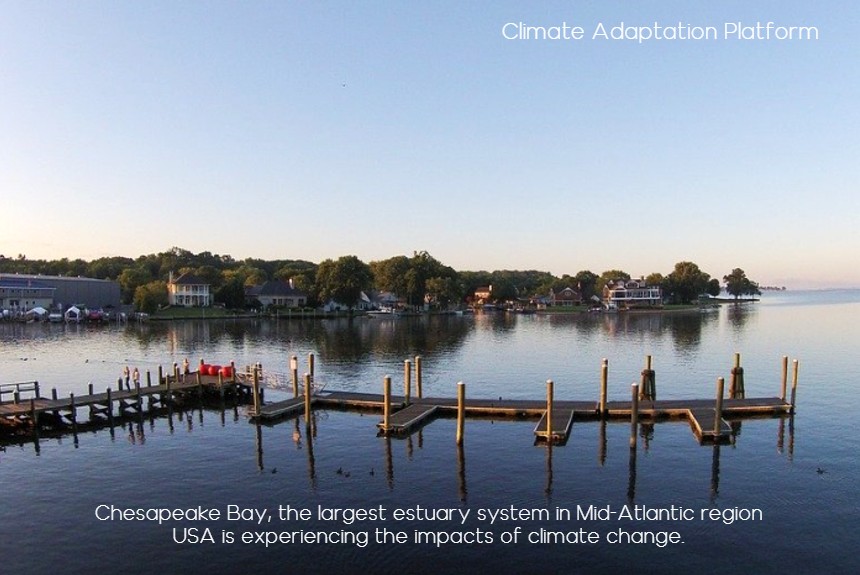Not only the low-lying Small Island Developing Nations in the Pacific are experiencing the impacts of climate change but also the Chesapeake Bay, the most extensive estuary system in the Mid-Atlantic region of the United States.
An article in the NY Times says that the Chesapeake Bay is at the ‘front-row view of the sea’s rapid advance.’
The article says that the area around the bay has seen the rapid intrusion of saltwater, says Keryn Gedan, a wetland ecologist at George Washington University.
The rate of sea-level rise is 5 millimetres per year, well above the global average of 3.1 millimetres up and down the mid-Atlantic coast in the US.
The Blackwater National Wildlife Refuge, located on Maryland’s eastern shore, lost 3,000 acres of forest and agricultural land between 1938 and 2006. More than 5000 acres of marsh became open water, which is where Dr Gedan conducted her research. Another Biologist, Matt Whitbeck, who also works in the refuge, found out in 2012 that the marsh was not disappearing. Instead, the article adds that it was ‘migrating’, and some of the 3,000 acres of forest the refuge lost were transformed into a saltwater marsh ( Manoff, M. V., 2019 ).
What contributes to the rapid sea-level rise
According to an article in the NY Times, the Gulf Stream slows down as Greenland’s melting water inhibits its flow. This piles up water on the East Coast, raising sea levels locally.
Dr. Gedan says this rapid sea-level rise on the East Coast is a “window into the future for the rest of the world” ( Manoff, M. V., 2019 ).
Effects of Sea-level rise according to Manoff’s article:
- In Dorchester County, the rise in sea level is killing loblolly pines, the most salt-resistant tree, compared to oak and other sensitive hardwoods.
- When these forests are dead, saltwater marsh plants move in, and the “cane-like Phragmites, an invasive plant, takes over.”
- The rapid rise of sea levels and increased drought events have both increased seawater intrusion to new places, gradually killing trees and creating ghost forests.
- The 5-millimetre sea level rise translates into saltwater inland intrusion at 15 feet per year, says Gedan.
‘Invisible flood’
When saltwater seeps into the soil before sea-level rise becomes obvious and kills sensitive plants far from the shore, the residents know this phenomenon as the “invisible flood.”
“You can’t see it,” says Elizabeth van Dolah, an anthropologist at the University of Maryland. She adds that communities see these happening at a ‘much quicker pace than in the past.’
The people living in the area have recognized this, and they will eventually have to leave, but they intend to stay for the time being.
To know what other places on the East Coast or the mid-Atlantic region are being affected by sea-level rise and salt intrusion, you can read the entire article by clicking on the button below:
Is it sea-level rise, or is the land sinking?
According to a study in the Harvard Gazette, sea-level rise is only a part of the picture, and the reason sea levels are rising is that land is sinking ( Reuell, P., 2019).
This is the key finding of a study recently published in Nature, co-authored by Professor of Earth and Planetary Sciences Peter Huybers, another Professor of Science and an assistant scientist at the Woods Hole Oceanographic Institution.
According to the study’s researchers, the reason for this land sinking is a large-scale response to the last ice age, which occurred between 20 and 95 thousand years ago. During this ice age, the Laurentide Ice Sheet, which covered most of northern North America, ‘levered the land upwards’. Huybers says, “Now, thousands of years after the ice is gone, the mid-Atlantic crust is still subsiding.”
This means a greater rate of sea-level rise along the mid-Atlantic because of the ‘effects of the natural subsidence of the land and human-caused in sea level’ and that ‘we need to prepare for this.
Click the button below to read the entire article:
Knowing more about sea-level
A NASA article explains it and the factors causing sea-level rise, particularly from land sinking or subsistence due to soil compaction, groundwater and hydrocarbon extraction caused by human activities, and tectonic forces, including the post-glacial rebound as part of the natural causes.
The article discusses post-glacial rebound, land subsidence, sea-level rise influenced by changes in gravitation at the local and regional levels, and terms like self-attraction and loading related to glacier formation and melting.
Read NASA’s article by clicking on the button below:
Sources:
Manoff, M. V. (2019, October 8). As Sea Levels Rise, So Do Ghost Forests. NY Times. Retrieved from https://www.nytimes.com/interactive/2019/10/08/climate/ghost-forests.html?searchResultPosition=1
Reuell, P. (2019, February 19). Study of sea-level rise finds land skinking along East Coast. The Harvard Gazette. Retrieved from https://news.harvard.edu/gazette/story/2019/02/study-of-sea-level-rise-finds-land-sinking-along-east-coast
Understanding Sea Level. (2019). NASA. Retrieved from https://sealevel.nasa.gov/understanding-sea-level/regional-sea-level/subsidence



Leave a Reply